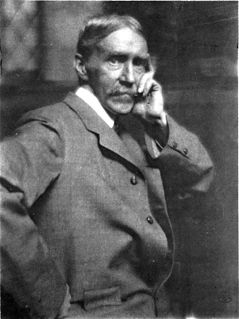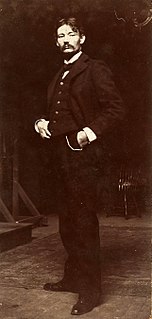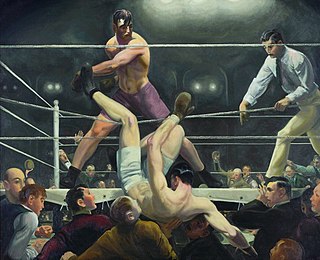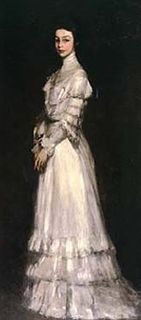
The Armory Show, also known as the International Exhibition of Modern Art, was a show organized by the Association of American Painters and Sculptors in 1913. It was the first large exhibition of modern art in America, as well as one of the many exhibitions that have been held in the vast spaces of U.S. National Guard armories.

Stuart Davis, was an early American modernist painter. He was well known for his jazz-influenced, proto-pop art paintings of the 1940s and 1950s, bold, brash, and colorful, as well as his Ashcan School pictures in the early years of the 20th century. With the belief that his work could influence the sociopolitical environment of America, Davis' political message was apparent in all of his pieces from the most abstract to the clearest. Contrary to most modernist artists, Davis was aware of his political objectives and allegiances and did not waver in loyalty via artwork during the course of his career. By the 1930s, Davis was already a famous American painter, but that did not save him from feeling the negative effects of the Great Depression, which led to his being one of the first artists to apply for the Federal Art Project. Under the project, Davis created some seemingly Marxist works; however, he was too independent to fully support Marxist ideals and philosophies. Despite several works that appear to reflect the class struggle, Davis' roots in American optimism is apparent throughout his lifetime.

George Benjamin Luks was an American artist, identified with the aggressively realistic Ashcan School of American painting.

John French Sloan was an American painter and etcher. He is considered to be one of the founders of the Ashcan school of American art. He was also a member of the group known as The Eight. He is best known for his urban genre scenes and ability to capture the essence of neighborhood life in New York City, often observed through his Chelsea studio window. Sloan has been called the premier artist of the Ashcan School, and also a realist painter who embraced the principles of Socialism, though he himself disassociated his art from his politics.

The Ashcan School, also called the Ash Can School, was an artistic movement in the United States during the late 19th-early 20th century that is best known for works portraying scenes of daily life in New York, often in the city's poorer neighborhoods.

Maurice Brazil Prendergast was an American Post-Impressionist artist who worked in oil, watercolor, and monotype. He exhibited as a member of The Eight, though the delicacy of his compositions and mosaic-like beauty of his style differed from the artistic intentions and philosophy of the group.

Jerome Myers was an American artist and writer associated with the Ashcan School, particularly known for his sympathetic depictions of the urban landscape and its people. He was one of the main organizers of the 1913 Armory Show, which introduced European modernism to America.

Robert Henri was an American painter and teacher.

William James Glackens was an American realist painter and one of the founders of the Ashcan School, which rejected the formal boundaries of artistic beauty laid-down by the conservative National Academy of Design. He is also known for his work in helping Albert C. Barnes to acquire the European paintings that form the nucleus of the famed Barnes Foundation in Philadelphia. His dark-hued, vibrantly painted street scenes and depictions of daily life in pre-WW I New York and Paris first established his reputation as a major artist. His later work was brighter in tone and showed the strong influence of Renoir. During much of his career as a painter, Glackens also worked as an illustrator for newspapers and magazines in Philadelphia and New York City.

Edward Willis Redfield was an American Impressionist landscape painter and member of the art colony at New Hope, Pennsylvania. He is best known today for his impressionist scenes of the New Hope area, often depicting the snow-covered countryside. He also spent his summers on Boothbay Harbor, Maine, where he interpreted the local coastline. He frequently painted Maine's Monhegan Island.

Ernest Lawson was a Canadian-American painter and a member of The Eight, a group of artists who formed a loose association in 1908 to protest the narrowness of taste and restrictive exhibition policies of the conservative, powerful National Academy of Design. Though Lawson was primarily a landscape painter, he also painted a small number of realistic urban scenes. His painting style is heavily influenced by the art of John Henry Twachtman, J. Alden Weir, and Alfred Sisley. Though considered an American Impressionist, Lawson falls stylistically between Impressionism and realism.

Everett Shinn was an American painter and member of the urban realist Ashcan School.

American Realism was a style in art, music and literature that depicted contemporary social realities and the lives and everyday activities of ordinary people. The movement began in literature in the mid-19th century, and became an important tendency in visual art in the early 20th century. Whether a cultural portrayal or a scenic view of downtown New York City, American realist works attempted to define what was real.
Kraushaar Galleries is an art gallery in New York City founded in 1885 by Charles W. Kraushaar, who had previously been with the European art gallery, William Schaus, Sr.

Edith Dimock was an American painter. Her work was exhibited at the 1913 Armory Show in New York. She married fellow artist, William Glackens, but continued to use her maiden name professionally after the marriage.

Mary (May) Wilson Watkins Preston was an American illustrator of books and magazines and an impressionist painter. She had an interest in art beginning in her teenage years, but her parents sent her to Oberlin College hoping that she would develop another interest. After three years, and at the urging of one of her teachers, Preston's parents allowed her to return to New York and attend the Art Students League. She then studied in Paris with James Whistler and next at the New York School of Art with William Merritt Chase.

The Palmer Museum of Art is the art museum of Pennsylvania State University, located on the University Park campus in State College, Pennsylvania.
James Moore Preston (1873–1962) was an American painter and illustrator, married to fellow artist May Wilson Preston. He was one of the Ashcan School, along with his friend, William Glackens.

The Wrestlers is a 1905 oil painting by George Luks held at the Museum of Fine Arts, Boston in Massachusetts, United States. The Wrestlers is Luks' best-known work. The painting depicts two nude men wrestling. He painted it in order to shock members of the Pennsylvania Academy of the Fine Arts whom he called "pink-and-white idiots". The Wrestlers was displayed at the 1908 Ashcan School exhibition. A 1910 article in New York World about the Exhibition of Independent Artists included an image of Luks' The Wrestlers despite the fact that the painting did not appear in that exhibition. In a 1908 diary entry, painter John French Sloan writes that The Wrestlers is among the best paintings he ever encountered. In 1992, art critic Carol Clark identified The Wrestlers as one of Luks' best works, calling it "raw, roughly painted" and reflective of Luks' experiences in New York. In 1996, Allen Guttmann compared Luks' The Wrestlers to Thomas Eakins' Wrestlers and Max Slevogt's Wrestling School, writing that all three paintings depict pairs of nude wrestling men lying on the ground in grappling holds. In the 2009 Dictionary of Modern and Contemporary Art, Ian Chilvers and John Glaves-Smith write that The Wrestlers emulates the "bravura painterly technique of artists such as Manet".

Walter Elmer Schofield was an American Impressionist landscape and marine painter. Although he never lived in New Hope or Bucks County, Schofield is regarded as one of the Pennsylvania Impressionists.



















